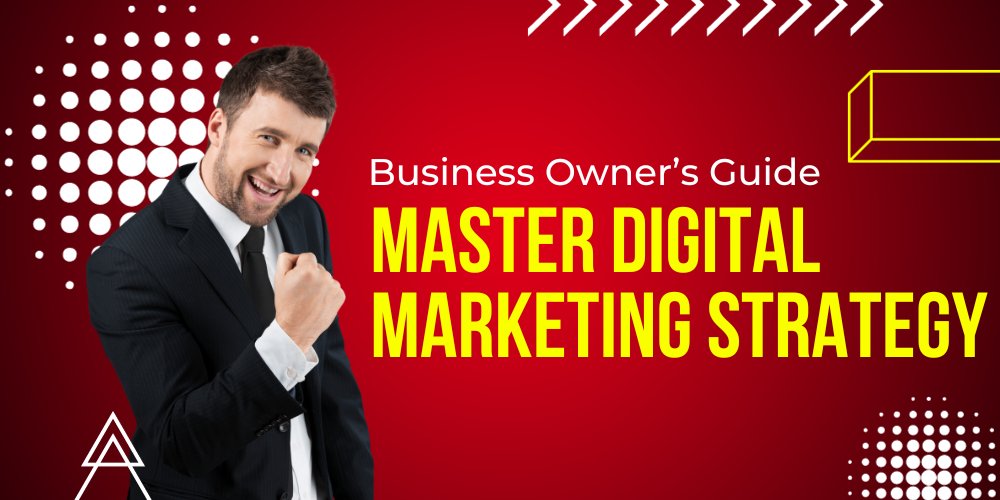The Ultimate Guide to Digital Marketing Strategies
Introduction:
Embracing the art of digital marketing is no longer an alternative in today's fast-moving digital economy; it is a need for organizations seeking growth online. This detailed setup will bring you through the complicated dynamics of digital marketing, helping you manage the enormous sea of possibilities through the internet and allowing you to design winning digital marketing strategies for businesses specific needs.
Understanding the Digital Landscape
Digital Marketing Evolution:
Digital marketing's growth is nothing short of a revolution. The digital environment has evolved from static webpages and simple search engines to an ever-changing ecosystem where innovation knows no boundaries. We've progressed from simple banner advertisements to full virtual reality experiences. Businesses today have a wide variety of tools and channels at their fingertips, allowing them to communicate with their target market in ways that were impossible only a decade ago.
Important Platforms and Technologies:
Understanding the major platforms as well as technology is similar to uncovering the digital code. Social media giants like Facebook, Twitter, and Instagram provide companies with extraordinary chances to build ecosystems, distribute content, and engage in important conversations with their target audience. Search engines like Google remain the main entrance to the internet, but new technologies like virtual reality (VR) and artificial intelligence (AI) are altering how businesses connect with customers and reducing the barriers between the physical and digital worlds.
Defining Your Business Objectives
Defining Specific and Measurable Goals:
The starting point of every effective digital marketing activity is goal clarity. Setting specific and measurable goals gives a blueprint for your efforts, whether your goal is to grow online sales, generate website traffic, or develop brand authority. Goals should be clearly defined as realizable, pertinent, and limited in time (SMART), providing purpose and direction to your digital activities.
Goals and Digital Marketing Strategy:
Once your goals have been established, the next critical step is to connect these goals to your digital marketing strategies for business. For example, if you want to increase brand awareness, spending money on content marketing and social media campaigns can help you get there. Focusing on search engine optimization (SEO) and email marketing can create leads of excellent quality that turn into repeat clients if lead creation is the primary goal.
Identifying Your Target Audience:
Conducting market research:
Market research serves as a guidepost for your marketing selections. It incorporates a thorough examination of market trends, customer preferences, and competitive landscapes. By conducting extensive market research, you may acquire vital insights into what your target audience wants, allowing you to customize your services and communications accordingly. This understanding is the foundation for successful digital marketing strategies.
Developing customer personas:
The imaginary characters who represent your ideal consumers are known as customer personas. Creating thorough personas requires an awareness of your target audience's demographics, psychographics, and habits. You are able to identify with your audience's wants and aspirations by making them human and building realistic characters, enabling you to design marketing campaigns that engage on a personal level.
Creating an Engaging Brand Story
The Crucial Role of Storytelling in Digital Marketing:
Storytelling emerged as a powerful weapon in the digital competition, where attention spans are short. A strong brand narrative goes beyond products and services to generate emotions and establish connections. It gives your brand a new life by injecting it with personality and meaning. A well-written narrative captures the soul of your company, making it unforgettable and accessible to your target audience.
How to Create an Interesting Business Narrative:
Creating an appealing brand narrative depends on the interweaving of genuineness, resemblance, and aspirations. Begin by recounting your brand's journey—the difficulties encountered, the lessons learned, and the victories enjoyed. Include customer testimonials and success stories that demonstrate real-world experiences with those items or services. Infuse your story with the principles of your business, emphasizing the positive influence your company seeks to make in the lives of its consumers. You engage your audience on a transforming journey via narrative, building a sense of loyalty and connection.
Constructing an attractive website
User-Friendly Design and Navigation:
Your website is your company's online storefront, the virtual area where initial impressions develop. A user-friendly website features simple design and navigation, allowing visitors to easily explore your offers. A wonderful user experience is created using clutter-free design, simple calls-to-action, and effortless navigation between pages. The simplicity with which visitors can locate information or make a purchase impacts their opinion of your business; thus, user-friendly design is a must-have component of your online identity.
Responsiveness and Mobile Optimization:
Smartphones' frequency has changed internet interactions. Mobile optimization confirms that your website is not just accessible, but also enjoyable to use on a wide range of items, including smartphones and tablets. Responsive design transforms your website's appearance and information to multiple screen sizes, removing the need for visitors to zoom or scroll extensively. The importance of mobile optimization in improving both user experience and search engine exposure is highlighted with Google's mobile-first indexing, which promotes websites that are mobile-friendly in search rankings.
Search Engine Optimization (SEO) Strategies
On-page SEO Optimization Techniques:
On-page SEO optimization means enhancing the ranking of individual web pages in search engine results pages (SERPs). This includes a wide range of tactics such as keyword optimization, meta tags, header tags, and picture optimization. Keyword research identifies the words and terms that your prospective customers are looking for, allowing you to carefully include them in the material you write. Thus, by optimizing these on-page features, you increase the exposure of your website and make it easier for search engines to read and rank your content.
Off-Page SEO Strategies and Link Building:
Off-page SEO refers to operations carried out outside your website in order to increase its authority and trustworthiness. A key component of off-page SEO is link building, which involves gaining high-quality backlinks from reputable websites in your area. These backlinks indicate to search engines that your website is reliable and useful, which improves your search rankings. Furthermore, social media signals, online discussions, and guest blogging are important off-page SEO methods that add to the online credibility of your website.
Content Marketing and Development
Creating a Content Strategy:
The technique of interacting with your audience regardless of your sales is known as content marketing. It includes developing and disseminating essential, relevant, and consistent information in order to attract and engage a certain audience. Understanding your audience's wants, preferences, and pain areas is the first step towards establishing a content strategy. By creating content that tackles these problems, you present your company as a helpful resource, increasing confidence and trust among your target audience.
Content Types: Diversification (Blogs, Videos, Infographics):
The secret ingredient to content marketing success is diversification. Different sorts of content are consumed by different audiences. Some people like the depth of a thoroughly researched blog piece, while others like the visual appeal of films and infographics. By varying your content formats, you may reach a larger audience and maximize your reach and effect. Explore different forms, such as podcasts, webinars, and dynamic quizzes, and personalize content according to your target segments' tastes.
Marketing on social media
Selecting the Best Social Media Platforms:
Not all social media sites are created equal, and they do not serve the same audience. The idea is to find the sites where your target audience hangs out. LinkedIn attracts companies targeting B2B clients and industry experts due to its professional priority. In contrast, Instagram and TikTok are popular among younger populations, making them perfect venues for lifestyle and customer-oriented businesses. Identifying the demographics, user behavior, and content formats of each platform allows you to carefully spend your resources on platforms that fit with the interests of your target audience.
Making Interesting Social Media Campaigns:
The electrical impulses of your online presence are involved in social media campaigns. They are discussions, experiences, and stories that are not just advertising. Visual material, such as photographs and videos, draws people in, while interactive components, such as polls, quizzes, and contests, stimulate engagement. Staging access, user-generated material, and customer testimonials offer genuineness, fostering a sense of community around your business. Your social media campaigns will become unforgettable experiences for your audience if you create real relationships and encourage emotional responses.
Email Marketing and Automation
Growing an Email Subscriber List:
Email marketing is still an indispensable tool in digital marketing strategies, providing a direct channel of connection with your target audience. Offering value in return for contact information is the first step in building an email subscriber list. Visitors are encouraged to subscribe to your email by offering exclusive discounts, instructive e-books, and free resources. Your email list, once subscribed, becomes an interested audience responsive to your messages and services.
Using Email Automation Tools:
Email automation boosts the efficiency and customization of your email marketing activities. Marketing Automation technologies enable you to deliver personalized messages to particular groups of your email list depending on user behavior, likes and dislikes, or past interactions. Automation ensures your communications reach the correct audience at the right time, improving engagement and conversion rates, whether it's a specific greeting email for new subscribers or abandoned shopping cart notifications for online shoppers.
Data Analysis and Iterative Improvement
Data Analytics' Importance in Digital Marketing:
Data is the money that powers educated decision-making in the digital environment. Data analytics provides insight into the effectiveness of your digital marketing strategies for business. Metrics like website traffic, conversion rates, bounce rates, and click-through rates reveal useful information about user behavior and preferences. By analyzing this data, you can determine what works, what needs to be improved, and which techniques resonate with your target audience. Data-driven decisions allow you to improve your efforts and ensure maximum impact and ROI.
Keeping Up to Date on Digital Marketing Trends
The Rapid Evolution of Digital Marketing Trends:
Digital marketing is a dynamic, ever-changing field in which remaining stable means falling below. Technological advancements, shifting customer behaviors, and algorithm upgrades from key platforms are driving the fast growth of digital marketing trends. Voice search, artificial intelligence, chatbots, and interactive content are a few examples of digital trends. By remaining current on these trends, you can keep your company on the cutting edge of innovation, ensuring that your plans remain relevant and powerful.
Conclusion:
To summarize, mastering digital marketing strategies for business is a process that involves a thorough grasp of your target audience, clear goals, appealing content, clever SEO, an active social media presence, successful email marketing, and decision-making based on data. By incorporating these aspects and remaining up-to-date on industry developments, business owners can successfully traverse the digital world, generating growth and developing an impressive online presence for their businesses.

